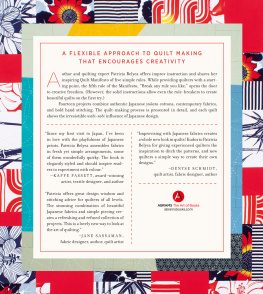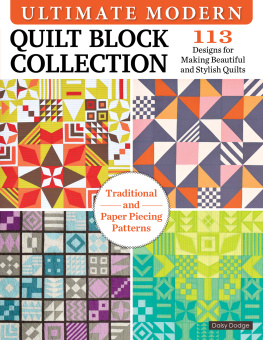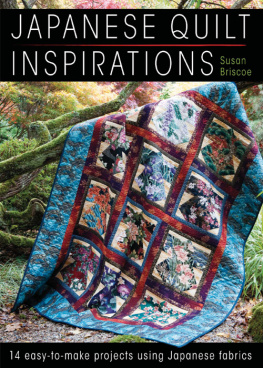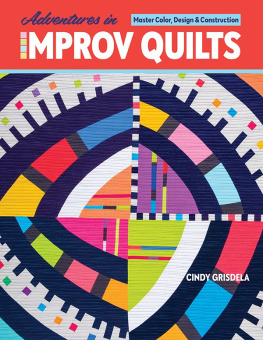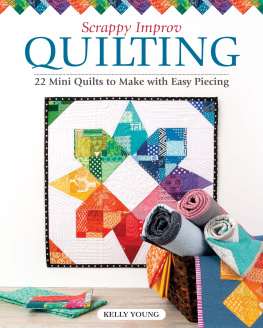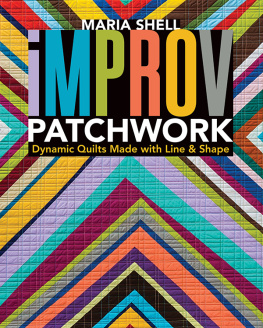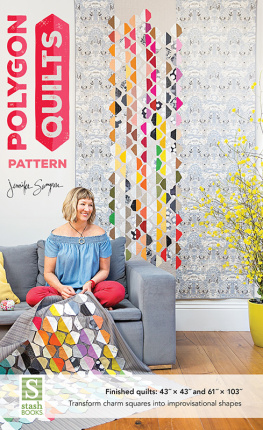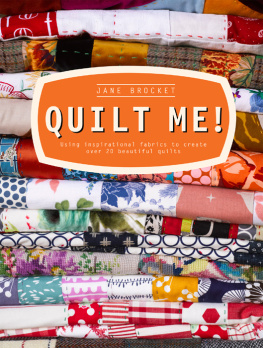

THANK YOU
TO FIVE SPECIAL WOMEN:
my mom, Jane,
who always encourages me;
my mentor, Maurine,
who shared so much with me;
my twin, Pamela,
who ceaselessly supports me;
and
my daughters, Liz and Victoria,
who let me be their mom.


Contents

Introduction
Welcome to my style of improv quilting, where Americana broken-rail blocks meet extraordinary Japanese fabrics. In combining elements from two diverse cultures, something new has emerged. I havent made these quilts umpteen times in a test studio, refining the colors, block placement, and stitching patterns until theyre perfect. Instead, Ive embarked on a personal adventure with each of these quilts. I want to teach you how to do the same.
CREATIVE FREEDOM
For me, its all about exploration. Developing my own pattern logic inspires my imagination. I love seeing the visual evolution as my quilts come together. My first action informs the next. Each step is filled with doing and discerning to bring my quilts to completion.
I invite you to make quilts with a similar intention. Enjoy the delight of discovery as you try something new. Give yourself permission not to know exactly where you are going. Yet note that creating improvisational quilts is never arbitrary or accidental: It requires active discernment in determining each design choice.
When improv quilting, remember: Its only fabric! Freestyle fabric cutting and sewing is a low-risk endeavor with a strong payoff of personal growth and empowerment. As you push into uncharted design territory, trust yourself. You can do this.
UNCOMMON FABRICS
Working with Japanese or Japanese-inspired fabricwhether vintage or contemporarywill transform your quilts into something out of the ordinary. Vintage Japanese cottons are typically hand-dyed with classic geometrics or luscious patterns. More modern fabrics offer traditional to outrageous printed motifs. And Japanese-inspired fabrics might emulate the intricate embroidery of an antique kimono or sport an anime character. Anything goes.
Treasure hunting plays an important role in collecting Japanese fabrics. This does not necessarily mean traveling to Japan and scouring the flea markets for exciting finds. Instead, try your local thrift stores, stop by estate sales, or visit the international district of your city. At your local textile shop, ask about the newest Japanese imports. The Internet is another great source: Many online fabric stores specialize in Japanese fabrics, and you can also find them on eBay and Etsy.
Your collection doesnt have to be a pile of authentic Japanese fabrics; you can also choose fabrics that remind you of Japanese motifs. The most important criteria? The fabric must please you and transport you to your vision of Japan.

GETTING STARTED
The Japanese appreciation of process rather than product aligns with my approach to improv quilting. I offer my guidance as you venture forward. Not everything can be explained by me. Instead, everything needs to be experienced by you.
If you are a beginner, all the production steps are included so you can start improv quilting. If you are an experienced quilter, you will be familiar with many of these instructions. No matter what your level of previous experience, now is the time to be curious and try new ideasto become fully alive with experimentation and ingenuity.



Explore Improv
ENGAGE IN THE JOY OF CREATION
The improv quilts in this book are based on the Hachi Quilt Manifesto (see ). The Manifesto provides you with a set of straightforward rules and gives you a place to start. The fifth and final rule is Break any rule you like, so you also have complete creative freedom.
When I try something new, I sometimes choose to quilt like a child. Wonder and curiosity embolden me to put fabrics together in novel ways just to see what will happen. Other times I opt to quilt like a divaboldly making moves as though I know what Im doing. Being decisive means taking risks, but also propels me in new directions.
There is no room for church mice in improv quilting. You have to own your ideas, your choices, and your determination. No teacher or sage will be there to cheer you on. There is only you in your sewing roomcutting and sewing, discerning and reworking.
Its all very simple, but not necessarily easy. I encourage you to embrace improv quilting. Before you know it, you will be surprising yourself with a new skill setthe ability to bravely go forward and create something that is all your own.
Most Favorable Hachi
THE JAPANESE NUMERAL EIGHT
Considered lucky in Japan, the Kanji character for hachi translates to eight. Hachi suggests growth and prosperity with its outward swooping lines.
The Hachi Quilt Manifesto specifies a final block size of 8 inches (20 cm). This size is perfect for flaunting the large-scale patterns of many Japanese fabrics. In addition, eight easily divides by four and two to make the Hachi Quilt block configurations with patterned and solid fabrics.
All the iterations of Hachi Quilts in this book share the common element of 8-inch (20-cm) square blocks. Beyond that, the quilts interpret the Hachi Quilt Manifesto in many diverse ways.
Hachi Quilt Manifesto
FIVE EASY RULES
1. MAKE EACH FINAL QUILT BLOCK 8 INCHES (20 CM) SQUARE.
2. MAKE BLOCKS WITH TWO FABRICS IN A RELATIONSHIP OF 1/4 + 3/4, 1/2 + 1/2, OR 3/4 + 1/4.

3. SET BLOCKS IN A HORIZONTAL THEN VERTICAL REPEATING PATTERN.

4. ADD AN UNEXPECTED VISITOR TO SPARK THE QUILT COMPOSITION.
5. BREAK ANY RULE YOU LIKE.

Next page
